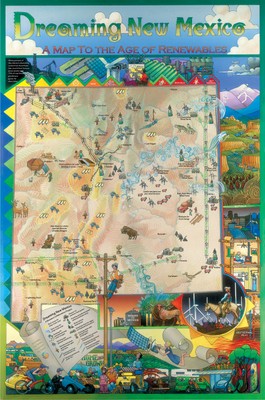What is our dream relationship with energy? How can New Mexico build an energy sector that uses low-carbon fuels?
The Dreaming New Mexico Project began as a refuge a place to step back and consider the limits we had placed on our sense of possibility. Imagine the year is 2020 and we’ve done everything right. What might New Mexico’s Age of Renewable Energy look like?
We conjured an Age of Renewables futures map and booklet envisioning the future.

We engaged a small circle of deeply involved citizen-experts, gathered masses of data, and conducted strategic research in areas that had been neglected. We took a systemic approach. As John Muir said, “Everything is hitched to everything else.” Human systems and natural systems are one entangled system. We cannot solve “issues” in isolation cashflows, energy flows, water flows, our sense of comfort and conscience web together. We heard the message: taking care of nature means taking care of people, and taking care of people means taking care of nature. Collectively, we custom-designed this Big Picture of “Energy in the Land of Enchantment” and distilled the dream into one long sentence.
New Mexico’s energy dream:
A reliable and secure energy supply for heating, cooling, transport and electricity (largely from renewable sources with excess for export), delivered at a fair price that helps create jobs and new businesses, curtails global warming, and does no harm to the health and environment of the state’s citizens.
New Mexico’s energy dream has five dimensions:
- renewables
- distributed energy (micropowers, microgrids)
- energy efficiency
- governing what we share (the energy commons)
- building an economy that does not damage the atmosphere or ourselves (the restoration economy)
Initiatives to implement all of these five dimensions are necessary to make our energy dream a doable dream.
As a doable dream, there are specific milestones:
- New Mexico moves dramatically away from fossil fuels and their greenhouse gas and toxic emissions.
- The state perfects generating its power from renewable power sources, capitalizing on its abundant solar, wind, geothermal and biofuels resources.
- The state moves toward much greater energy efficiencies: zero-emission buildings, improved power production, low-carbon fuels, more work per unit energy, fewer miles traveled and demand response around peak power periods.
- The state moves away from imported power with its inefficient line losses and its price insecurity.
- New Mexico builds hundreds of local power grids that encompass islands of homes and businesses that generate their own power. These distributed micropowers and microgrids produce their own electricity and heat and feed each other through “smart substations” and short, low voltage wires.
- New Mexico designs a “green grid” that transports solar and wind electricity (not coal-fired electricity) with more local, secure, efficient, and reliable power generation and distribution. All new export power lines carry renewable energy.
- The state and region reconfigure and invent new human organizations (in business, town-city- state-tribal-regional governments) that can better align pricing and energy supply with climate change, security, and equity concerns.
- New Mexico curtails global warming by well targeted public funding, green-collar jobs, renewables research and manufacturing, tax and rate structure incentives, intelligence, imagination, and educational facilities. County and local governments nurture walkable neighborhoods, and leaner end-use efficiencies. Distributed solar and wind systems as well as parked cars and industries feed the grid while you work, answering the peaking power challenge.
The grid connects us to all of North America, and cashflows and greenhouse gases connect us to the entire planet. The Age of Renewables offers hope. It invites us to unleash our dreams to create a future we would like to live in, one we want for our grandchildren.
Peter Warshall and Kenny Ausubel
Project Co-Directors
On the road in NM
Covering nearly 800 miles of New Mexican highway, we gathered stories and photos of the energy situation in our home state.
NM Energy Facts
- New Mexico’s population: 2 million (2006). Per capita income $29,673 (lowest in nation).
- New Mexico’s capacity to produce electricity: 7,100 megawatts (2002).
- In-state New Mexico electricity: natural gas (22%), coal (67%), dual-fired (9%), hydropower (1%); less than 1% from petroleum, nuclear and renewables.
- The state ranks 48 among 50 in its use of alternative energy. It is 41st for use of recycled waste. It is 14th in air pollution and toxic releases.
- About 30 to 40% of the electricity generated, mostly from coal, is exported. Forty per cent of the mined coal goes by rail to Arizona for power production. Less than 10% of New Mexico’s natural gas is used within the state.
- New Mexico is a leading US producer of crude oil and natural gas. The San Juan Basin, located in New Mexico and Colorado, contains the nation’s largest field of proved natural gas reserves and is the leading coalbed methane basin, producing about 30% of all US coalbed methane. There are over 40,000 oil and gas wells. New Mexico’s Permian Basin holds three of the 100 largest oil fields in the United States.
- Two thirds of households use natural gas as their primary source for home heating. A little more than 10% of New Mexican households use electricity.
- New Mexico imports electricity from Palo Verde Nuclear, Western Association of Power Authorities (Colorado River), El Paso Electric (Texas) and Tri-State Coop (various).
